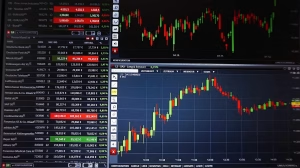Index Trading Strategies – Index trading has become one of the most popular forms of trading among both retail and institutional investors. Rather than betting on a single stock, traders can speculate on the performance of an entire market or sector. This offers broad exposure, reduced volatility, and ample opportunities for profit—if you apply the right index trading strategies.
In this article, we’ll explore the fundamentals of index trading, outline various strategies for different experience levels, and provide tips for successful execution in today’s fast-paced markets.

What Is Index Trading Strategies?
Index trading involves buying or selling a financial instrument—typically a futures contract, ETF, or CFD—that tracks the performance of a market index. A market index is a collection of selected stocks that represent a particular segment of the financial market.
Common indices include:
- S&P 500 – Tracks 500 large-cap U.S. companies.
- NASDAQ 100 – Focuses on the top non-financial tech-oriented companies.
- Dow Jones Industrial Average (DJIA) – Represents 30 major U.S. corporations.
- FTSE 100 – Covers the top 100 U.K. companies.
- Nikkei 225 – Tracks major Japanese companies.
By trading indices, investors can take a position on the general direction of a market rather than on individual stocks.

Index Trading Strategies
Why Trade Indices?
Before diving into index trading strategies, it’s important to understand why index trading is attractive:
- Diversification:
Indices spread risk across multiple stocks, reducing the impact of one company’s performance.
- Liquidity:
Major indices are highly liquid, meaning you can enter and exit trades with ease.
- Efficiency:
Instead of analyzing dozens of stocks, you focus on broader economic and market trends.
- Access to Global Markets:
Index trading allows exposure to domestic and international markets.

Top Index Trading Strategies
Here are some of the most effective and widely used index trading strategies, suitable for traders of all experience levels.
1. Trend Following Strategy
This is one of the simplest yet most powerful strategies. It involves identifying and riding the direction of the prevailing market trend—upward (bullish), downward (bearish), or sideways (consolidation).
How it works:
- Use indicators like moving averages, MACD, or ADX to identify trends.
- Enter long positions in an uptrend or short positions in a downtrend.
- Place stop-loss orders to protect against reversals.
Example:
If the S&P 500 breaks above its 50-day and 200-day moving averages with high volume, it’s often a bullish signal to enter a long position.
2. Breakout Trading Strategy
This strategy focuses on trading the breakout of significant price levels—support, resistance, or key chart patterns.
How it works:
- Identify consolidation patterns (triangles, flags, channels).
- Set entry orders just outside the breakout levels.
- Confirm breakouts with volume or momentum indicators.
Tip: Be cautious of false breakouts—wait for confirmation like a retest of the breakout zone or sustained price movement.
3. Mean Reversion Strategy
This strategy is based on the idea that price tends to revert to its average or mean over time. It works well in range-bound markets.
How it works:
- Use indicators like Bollinger Bands, RSI, or moving averages.
- When the index moves too far from the mean (e.g., RSI > 70 or < 30), prepare for a reversal.
- Enter contrarian trades expecting a return to the mean.
Example:
If the NASDAQ 100 is significantly overbought and hits the upper Bollinger Band, a short trade may be considered for a mean reversion.
4. News and Economic Event Trading
Economic reports, central bank announcements, or geopolitical events can have a dramatic impact on indices.
How it works:
- Follow an economic calendar (e.g., for U.S. Non-Farm Payrolls, inflation data, or Fed interest rate decisions).
- Trade based on market expectations vs. actual results.
- Use tight risk controls as volatility can spike.
Tip: Trade only after the news is released if you want to avoid unexpected swings (this is called a post-news trading strategy).
5. Swing Trading
Swing trading involves holding positions for several days to weeks, aiming to capture medium-term moves.
How it works:
- Analyze daily and 4-hour charts for trends and setups.
- Use a mix of fundamental and technical analysis.
- Look for reversals, pullbacks, or breakouts.
Tip: Swing trading is ideal for those who don’t want to monitor markets constantly but still want to be actively involved.
6. Scalping
Scalping is a short-term strategy focused on making multiple small profits throughout the day.
How it works:
- Trade on 1-minute to 5-minute charts.
- Focus on highly liquid indices (like the S&P 500 or DAX).
- Use high-frequency setups and tight spreads.
Warning: Scalping requires fast execution, low latency, and strict discipline. It’s not recommended for beginners.
Tools and Indicators for Index Trading
To implement your strategy effectively, consider using these tools:
- Moving Averages
(EMA, SMA): Identify trends.
- RSI (Relative Strength Index):
Spot overbought or oversold conditions.
- MACD:
Momentum and trend direction.
- Bollinger Bands:
Volatility and mean reversion.
- Volume:
Confirm strength of a price move.
- Fibonacci Retracement:
Identify support and resistance levels.
Risk Management Tips
Regardless of the strategy, every trader must manage risk to avoid significant losses.
- Use Stop-Loss Orders:
Set predefined loss limits.
- Position Sizing:
Never risk more than 1–2% of your capital on a single trade.
- Avoid Overtrading:
Focus on quality setups, not quantity.
- Diversify:
Don’t rely on one index or one strategy.
- Journal Your Trades:
Track what works and what doesn’t to refine your approach.
Common Mistakes in Index Trading
Avoid these pitfalls:
- Chasing the market after a move has already started.
- Overleveraging, which can lead to large losses.
- Ignoring macroeconomic factors that influence index behavior.
- Holding on to losing positions due to emotion or ego.
Final Thoughts: Choosing the Right Index Trading Strategy
The best index trading strategies depend on your goals, time commitment, and risk tolerance. Long-term investors might favor trend-following and swing trading, while active traders could benefit from scalping or breakout strategies.
No single method guarantees success, but combining technical analysis, risk management, and consistent execution can lead to profitable outcomes over time. As always, start small, backtest your approach, and keep learning from your trades.
For more updates, visit https://tradingmarketsignals.com/








